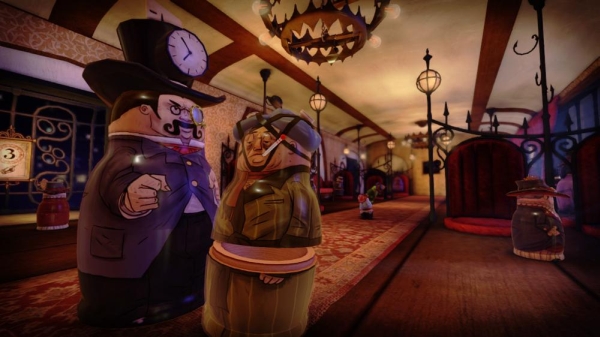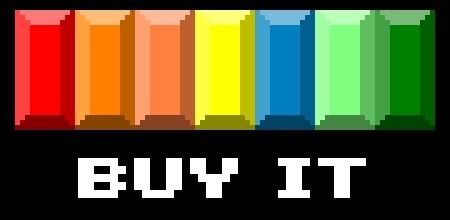
In a space where a million small studios are trying to make the next big hit, world-class developer Double Fine productions returns to the downloadable scene with Stacking. From the mind of Art Director Lee Petty and under the mantle of the legendary Tim Schafer, this puzzle-solving adventure game combines pleasantly appealing visuals and intuitive gameplay with the social commentary and quirky humor of the era of silent films.
Platforms: PS3 (Version Played), Xbox 360
Publisher: THQ
Developer: Double Fine Productions
Genre: Matryoshka Puzzle Solving
Release Date: February 8, 2011 (PS3), February 9, 2011 (Xbox 360)
ESRB Rating: Everyone
 When you first load up Stacking, you don’t really know what to expect. A lengthy opening cutscene introduces you to Charlie Blackmore and his impoverished family of chimney sweeps. The father gets promoted, promising greater living conditions for his family, but disappears after his first day. With the landlord threatening to evict the family, the children make the tough decision to enter the work force themselves, over the objections of their mother. The Blackmore siblings also disappear, leaving Charlie – the youngest sibling and smallest Russian doll in history – alone with their mother. Despite his small stature, Charlie takes it upon himself to head out into the world and investigate what’s happened to his family.
When you first load up Stacking, you don’t really know what to expect. A lengthy opening cutscene introduces you to Charlie Blackmore and his impoverished family of chimney sweeps. The father gets promoted, promising greater living conditions for his family, but disappears after his first day. With the landlord threatening to evict the family, the children make the tough decision to enter the work force themselves, over the objections of their mother. The Blackmore siblings also disappear, leaving Charlie – the youngest sibling and smallest Russian doll in history – alone with their mother. Despite his small stature, Charlie takes it upon himself to head out into the world and investigate what’s happened to his family.
There’s a lot to be said about the story and presentation here. The artwork presents the scenery like a giant toy box, with dominoes the size of characters scattered around the level. A lot of it evokes shades of LittleBigPlanet, as some of the backgrounds like the ocean waves look like stationary materials a young child would use in a diorama. The setting stirs up images of the Great Depression, spiced up with a bit of Victorian flair. To tell a story about labor issues in such a setting, Double Fine picked the most complementary storytelling format they could – the game strongly takes after the Charlie Chaplin silent films. Stacking executes its social commentary through the scenery and remarks of the characters instead of insulting your intelligence and spelling them out for you. Like Chaplin’s work, the game utilizes overwhelming irony, which you really have to experience for yourself as it’s one of the most enjoyable aspects of the game. The medium of silent film itself buttresses the artistic quality, as the slight movements of the film reel tops off all the effort. Finally, sticking to the silent format and foregoing voice actors really was the right choice. Any attempt at vocalizing the hilarious dolls would have come off as corny instead of classy, sinking any chance of the game being as good as it actually is here.
Creating rich, well thought out worlds is where the studio clearly shines, but the gameplay is just as endearing. As the smallest doll in the world, Charlie can stack up inside of other dolls and control them to use their abilities. These can be as simple as giving a handshake or as specialized as a mechanic who’s the only one who can operate the special maintenance switches. In each scenario the player is asked to find dolls who can solve the problem at hand, usually opening up new pathways but also coaxing guards away from their posts so he can sneak in or rescue an important character.The more difficult puzzles involve stacking to collect characters of different sizes, bringing them over to the problem area, and then unstacking them to accomplish a specific task. Sometimes, it allows you to combine abilities, like pouring gasoline on a character’s flare to make it brighter; in other instances, you use a bird or some such to move a smaller character to an area previously unreachable, where you can then use their ability to solve another part of the puzzle. Overall it’s an extremely clever use of the choice of characters, and seeing it work together makes you pleased Double Fine didn’t go the generic route and make a platformer or action game with stacking dolls as communists or some other Russian stereotype. It’s this kind of ingenuity that defines it as a studio and makes it a very dangerous competitor in the downloadable space.

What makes the variety of different dolls and their abilities so effective is the open nature of the game. The world has a total of five areas, with one of them also acting as a hub to get to the others. For the most part you can take care of the story objectives in any order you wish, and in most cases there are at least three different ways to tackle each situation. Finding a simple solution is easy enough, but for a lot of the more creative solutions you usually have to seek out rarer, one-of-a-kind dolls. After completing each main area, one of Charlie’s friends creates murals depicting your adventures in a remote section of the hub, where he also displays the rare dolls you acquired from that level. Everything comes together to take an already delightful experience and turn it into an addicting completionist challenge, as you scour every nook and cranny to stack up into rare dolls and use them to accomplish the more obscure solutions.
But these obscure puzzles are optional and therein lies the only real complaint with a game that nails gameplay and aesthetics so well. I’m hardly a fan of puzzle-solving, but I was never stuck for more than a few minutes. I’ve played God of War games that had more challenging puzzles than what it took to beat this game, which honestly I would have liked to have been a little longer. Of course, the crazier solutions will demand a lot more ingenuity and seriously add to the playtime, but it would’ve been nice to get that great feeling after solving a seemingly insurmountable puzzle that’s mandatory to the story. I read that Double Fine wanted to make a game that casual players could play and finish without getting frustrated while hardcore gamers could get a ton of bang for their buck. I suppose the game is a resounding success in that regard, but the deficiency still remains. I understand this medium is driven by the fact that it’s a business. But a reviewer who thinks it’s important to broaden gaming’s audience, and factors that into the equation of a title’s quality, overestimates the virtue of the former and clearly does not understand the latter.
As harsh as that sounds, the lack of length and difficulty does not make Stacking a bad game. On the contrary, it’s the only thing stopping it from being a perfect game. If you’re a PlayStation Plus subscriber, you absolutely have to scramble to get your free download of this game before the month is over. If you own an Xbox 360 or are just a regular PSN user, the $14.99 price tag may be a little steep for the short story. However, the alternate solutions, side challenges, Hi-Jinks challenges, and finding all the rare dolls to complete your mural collection make it worth every penny – not to mention that all of this takes place in one of the most unique, must-see settings on XBL and PSN.

Review Disclosure: A retail copy of Stacking was purchased by Warp Zoned for the purposes of this review.






